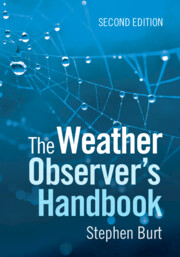Book contents
- The Weather Observer’s Handbook
- Reviews
- The Weather Observer’s Handbook
- Copyright page
- Dedication
- Epigraph
- Contents
- Foreword
- Acknowledgements
- Author’s note
- Abbreviations, footnotes and references
- Part I The basics
- Part II Measuring the weather
- 4 Site and exposure: The basics
- 5 Measuring the temperature of the air
- 6 Measuring precipitation
- 7 Measuring atmospheric pressure
- 8 Measuring humidity
- 9 Measuring wind speed and direction
- 10 Measuring grass and earth temperatures
- 11 Measuring sunshine and solar radiation
- 12 Observing hours and time standards
- 13 AWS data flows, display and storage
- 14 Non-instrumental weather observing
- 15 Calibration
- 16 Metadata: What is it, and why is it important?
- Part III Making the most of your observations
- Book part
- References and Further Reading
- Index
5 - Measuring the temperature of the air
from Part II - Measuring the weather
Published online by Cambridge University Press: 21 May 2024
- The Weather Observer’s Handbook
- Reviews
- The Weather Observer’s Handbook
- Copyright page
- Dedication
- Epigraph
- Contents
- Foreword
- Acknowledgements
- Author’s note
- Abbreviations, footnotes and references
- Part I The basics
- Part II Measuring the weather
- 4 Site and exposure: The basics
- 5 Measuring the temperature of the air
- 6 Measuring precipitation
- 7 Measuring atmospheric pressure
- 8 Measuring humidity
- 9 Measuring wind speed and direction
- 10 Measuring grass and earth temperatures
- 11 Measuring sunshine and solar radiation
- 12 Observing hours and time standards
- 13 AWS data flows, display and storage
- 14 Non-instrumental weather observing
- 15 Calibration
- 16 Metadata: What is it, and why is it important?
- Part III Making the most of your observations
- Book part
- References and Further Reading
- Index
Summary
In order to provide representative measurements of air temperature, thermometers must be deployed in suitable locations or sites and the sensors themselves exposed to the weather conditions they are intended to measure in a standardised manner. This chapter sets out what those standardised conditions of site and exposure are for measurements of air temperature, following the guidelines laid down by the World Meteorological Organization in the so-called CIMO guide (Commission for Instruments and Methods of Observation). As a result of the UN Minamata Convention, traditional mercury-based thermometers have been progressively withdrawn from observation networks, and this chapter considers both their replacement by electronic sensors and impacts of that changeover. Alternative methods to measuring air temperature in the traditional Stevenson screen or Cotton Region Shelter, particularly aspirated temperature measurements, are also covered in detail.
Keywords
Information
- Type
- Chapter
- Information
- The Weather Observer's Handbook , pp. 102 - 139Publisher: Cambridge University PressPrint publication year: 2024
